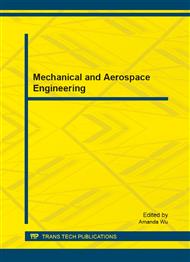p.869
p.874
p.878
p.885
p.891
p.895
p.899
p.904
p.908
Fatigue Reliability of Selective Laser Sintered (SLS) Components Using Weibull Analysis
Abstract:
Selective laser sintered metallic specimens were tested for fatigue cycles to failure and analyzed for reliability. In this study, Taguchi’s experimental techniques were used to develop a modified L9 orthogonal array. Three different process parameters, laser power, scan spacing and slice thickness were selected for manufacturing the components. Fatigue testing was carried out as per ASTM standards and relationship of the process parameters on the fatigue cycles to failure was investigated. ANOVA method was used to find the dependence of the process parameters and to find the influence of main process parameter on fatigue cycles to failure of the specimens. Laser power was found to be the most significant factor compared to scan speed and slice thickness. Two-parameter Weibull method was used for the reliability studies by which reliability was estimated for different cycles to failure.
Info:
Periodical:
Pages:
891-894
Citation:
Online since:
November 2012
Authors:
Price:
Сopyright:
© 2012 Trans Tech Publications Ltd. All Rights Reserved
Share:
Citation:


